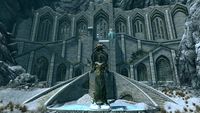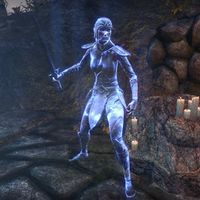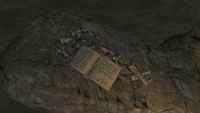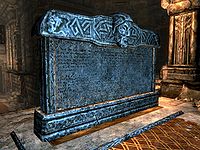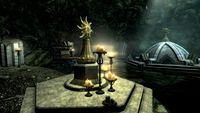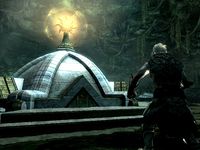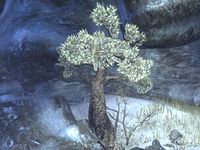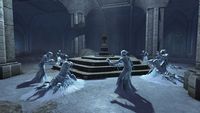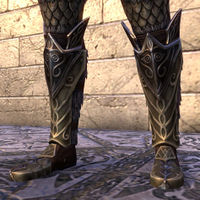Lore:Snow Elf

This article is about the race. For the creatures, see Falmer.
The Snow Elves, also known as the Ancient Falmer or Ice Elves,[1][2] are a proud race of mer with an unusually great aptitude for magic. They tend towards cold, remote regions,[3] and inhabited most of Skyrim and some sites in High Rock,[4][UOL 1] before being displaced by the Nords in the late Merethic Era and early First Era.[5] Before that, they had a civilization which rivaled even the Altmer of the Summerset Isles. They resemble the Altmer in build, being white-haired, pale-skinned, and have very long lifespans, as well as a strong resistance to frost,[6] to the point where they were immune to cold and could live comfortably in ice caverns.[7]
Much as "High Elf" and "Wood Elf" are interchangeable with "Altmer" and "Bosmer" respectively,[8] "Falmer" is really just another term for "Snow Elf".[9][10] However, most people, even the Snow Elves themselves, demonstrated a preference for "Snow Elf".[5][11][12] In this case, time eventually provided distinct meanings for the two terms. Many of the ancient Snow Elves were betrayed in a deal for asylum they struck with the Dwemer. The Dwemer forced their wards to subsist only on toxic fungi which twisted them into sightless slaves. It is the hideous descendants of these slaves, whom other Snow Elves called "the Betrayed", who have come to represent the Falmer to many of the people of Tamriel. People often refer to the grand ancient race of Skyrim elves as Snow Elves, and to their barbaric remnants as Falmer.[5][6][13]
Few know that an unknown number of civilized Snow Elves rejected the Dwemer's deal. Even fewer know that some have survived, uncorrupted, into modern times. Knight-Paladin Gelebor of the Chantry of Auri-El, the only known and potentially last Snow Elf still alive today, embraced this distinction between "Falmer" and "Snow Elf" because of the negative connotations "Falmer" had accumulated over the millennia.[5][14] Gelebor believes it is possible that there are some other isolated conclaves of surviving snow elves nestled elsewhere on Nirn.[5]
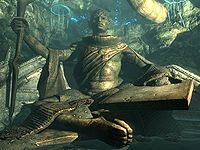
History[edit]
It is unclear whether other mer also inhabited Skyrim (besides the underground Dwemer and ancient Orcs in strongholds);[15] early accounts are mostly from the Nordic perspective, which usually only refer to "the elves" without making distinctions. But elves in ancient Skyrim are assumed to be Snow Elves, in whole or in part.
The empire of the Snow Elves was expansive, wealthy, and prosperous in the Merethic Era.[5] They displayed power beyond what could be expected of the time.[16] The Snow Elves were constantly in conflict with the proto-Nords coming over from Atmora.[5] In other parts of Tamriel, Nedic peoples either cohabited with or were enslaved by various elven races. Only in Skyrim did relations break down between the Atmorans and the Snow Elves into widespread conflict. It's unknown when the conflict began; the earliest human settlements in Tamriel date back to ME800-1000, and sources suggest the relationship remained relatively harmonious for some time.[9][17]
The Return[edit]
The Snow Elves attacked Saarthal during the late Merethic Era.[16][18] Why the elves of Skyrim instigated the Night of Tears is disputed; attributed motives include fear, religious and military provocations, territorial disputes, and a desire to possess an ancient power the humans had uncovered (the Eye of Magnus).[6][9][16] Regardless, the elves attacked the human capital of Saarthal one night and razed it to the ground.[16] The only known survivors were the Atmoran-born ruler Ysgramor, as well as his two sons Yngol and Ylgar. They fled to Atmora, only to return with a vengeance. Ysgramor's Five Hundred Companions wiped out any elves they came across, clearing the way for more settlers to come in their wake.[19] The Nords reportedly killed the Snow Elves by the thousands,[20] fashioning their ears into necklaces as morbid trophies.[21] Their descendants continue to glorify their ancestors' genocidal attacks against the Snow Elves; one of the most popular songs in Skyrim is "The Slaying of the Falmer Princes".[6]
After wiping out organized elven resistance in Skyrim, the Nordic armies sought their enemy out on the island of Solstheim. The elves made a last stand in the Battle of the Moesring: after an intense battle, their leader, the Snow Prince, was killed, and the elves were routed.[22] The age of the Snow Elves was done.[11]
Though they steadily lost ground, the Snow Elves had been firmly entrenched in Skyrim, and they persevered into the early centuries of the First Era. In fact, the massive yet well-hidden Chantry of Auri-El, a great magical and architectural achievement even by today's standards, had not even been constructed by the Snow Elves until the early First Era.[5] It was not until the reign of High King Harald (1E 143-221) that the elves were believed to have been driven from the present borders of Skyrim,[9] though the Snow Elves continued to hide in the newly-established Nordic kingdom.[6][11]
The Ship of Ice, a Nordic sailor tale, recounted the freezing of Atmora and the last ship that left Jylkurfyk. In the story, a Snow Elf child approached the sailors in the port of Julkurfyk, unfazed by the freezing cold. She delivered a message about the consequences of their actions, stating that while they had destroyed her homeland with their weapons, the Frostfall had now claimed theirs. She urged them to look upon the frozen shores one last time and recognize that this was the result of the choices made by their forefathers.[23]
The Disappearance of the Snow Elves[edit]
The Snow Elves had long maintained an uneasy alliance with the only other known group of mer who inhabited Skyrim: the Dwemer. The Nords established their supremacy in Skyrim, and after the devastating loss of the Snow Prince,[2][11] most Snow Elves turned to their underground brethren for help.[13] After all, there were many Snow Elf legends lauding the honor and glory of the Dwemer.[24] The Dwemer offered to provide them a haven, but forced their wards into servitude, only allowing them to consume a toxic fungus which rendered them blind. Over time, the servants became slaves.[13] Ancient torture chambers found in Dwemer ruins are suspected to have been used to keep their elven brethren in line.[14] While these Snow Elves are believed to have been rendered blind by the Dwemeri toxin, it's unknown whether it was this or some other tragedy which twisted the Betrayed into the primitive creatures which have terrorized the Nords for millennia: the Falmer.[5][6]
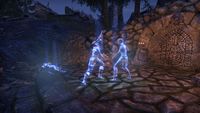
Some Snow Elves managed to avoid becoming slaves to the Dwemer, instead retreating to hidden shrines or hiding with sympathetic families.[11] The Marobar Sul story The Snow Elf and the Variation-Lens provides an account of one Snow Elf escaping Dwemer slavery.[25] Over a hundred were at the isolated Chantry of Auri-El when the Dwemer made their offer, and by the time news of it reached them, they were too late to stop it.[5] These few remaining Snow Elves look upon their twisted brethren with pity. However, these sentiments were not shared by the Falmer, as they attacked their untainted cousins with the same ferocity that they displayed towards the other surface races.[14]
Over the ages, the Snow Elves fell into legend.[nb1] One story tells of the ancient Snow Elf wizard named Serenarth, who was shot by an arrow from Ysgramor's bow Long-Launcher during the Night of Tears, and with his last strength summoned a mighty frost atronach and he traded the Daedra's spirit with his own. To this day, Serenarth's host form waits, encased in ice within a glacier close to where his frozen corpse still lies, destined to thaw out and seek vengeance on Ysgramor's heirs.[26] The Gwylim scholar Amalien developed a theory about the elves involving Dragons, Dwarves, Magnus the Divine, a band of plucky Atmoran skalds, and a six-legged mammoth.[27] By the time of the Interregnum, peoples of Tamriel believed the Snow Elves to be extinct, near-forgotten Nord legends and the fact that they'd degenerated underground into the feral Falmer was a deep secret.[UOL 2][UOL 3] There were few reported sightings of Falmer on the surface,[28] and testimonies that the Falmer were once Snow Elves were deemed to be "outlandish claims" by Imperial scholars.[29]
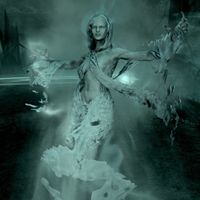
One of the first real pieces of evidence establishing that the Snow Elves had existed was the discovery of the Snow Prince's remains in Jolgeirr Barrow on the island of Solstheim in 3E 427.[31] Traces of the Snow Elves may be present in the mer of today, as it's suspected that many interbred with other elves before they ceased to exist as an identifiable culture.[3] The Skaal believe that the rieklings of Solstheim are descendants of the Snow Elves, although scholars argue that they are simply snow goblins.[3][32] Some legends claim Wispmothers are the last remnants of the Snow Elves,[30][33] which is supported by their behavior and tapered ears. Legends say that one of the reasons Snow Elves met their fall was due to the god of luck, Sai, who brought luck to Skyrim for the Nords, neglecting the Snow Elves.[1]
By 4E 201, what was once superstition had become, more or less, common knowledge: the increased activity of the underground Falmer made it increasingly difficult to dismiss them as myths. It is thought that their activity is related to a planned invasion of the surface world.[13][34] Other elves are repulsed by the idea that these Falmer were once mer like themselves, and many wonder whether these monsters are truly all that remain of the legendary Snow Elves.[6] Around this time, the Great Statue of Irkngthand, built in secret by the Betrayed, was discovered by the Thieves Guild.[35] It was perhaps the only known depiction of the ancient Snow Elves. However, when the thieves removed the Eyes of the Falmer (which are giant gems of enormous value), it caused the cavern to collapse, burying this priceless treasure.[6]
Society[edit]
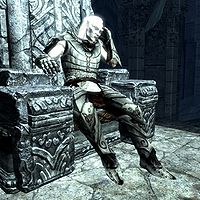
Little is known of the Snow Elf society, other than that it parallels that of the Altmer. They kept in contact with other elven kingdoms. They developed a complex and nearly indecipherable language. Only a few people in Tamriel can even recognize their alphabet, let alone read it, making it an ideal cipher for anyone with the proper knowledge seeking to encode their writings.[20][36] They developed their own method of telling time, and magnificent architectural achievements, among other things.[6] Their statues were still remembered for their magnificence.[37] As they were able to inhabit freezing ice caverns, they are said to have bred a species of snow-cedar so hardy it can live even within the heart of a glacier.[7] The Altmer and Snow Elf pantheons overlap significantly, possibly entirely: both acknowledge Auri-El as the sovereign and venerate Trinimac, Syrabane, Jephre, and Phynaster.[5][38] They had temples to all of them, though none were as impressive as their Chantry of Auri-El.[5] Their writings reference "Young Ones" and "Old Ones", though how precise this distinction is and its significance in their society is unknown.[11][24]
Many of the most dedicated Snow Elves once committed themselves to a tireless journey through the massive Chantry of Auri-El, carrying with them the paramount desire to become one with their god, Auri-El.[5][39] Of those who desired this, many once tried to be, but only six succeeded - the Knight-Paladin Gelebor, and the reanimated ghostly Prelates. Prelate Sidanyis, Prelate Athring, Prelate Celegriath, Prelate Nirilor, and Prelate Edhelbor all succeeded, but with the fall of the Snow Elves, they were given immortality past death by Auri-El.[40] After it was constructed in the mythical Forgotten Vale of western Skyrim, the Chantry quickly became the epicenter of the Snow Elf religion. The retreat was designed for those who wished to become enlightened. Initiates entered the Chantry through a cave representing the absence of enlightenment, and carried a ceremonial ewer to each of the wayshrines, small sites of worship which were scattered throughout the Chantry which were used for both meditation and transportation. Each shrine was tended to by a Prelate, who taught the initiates the mantras they were supposed to recite. After visiting the Wayshrines of Illumination, Learning, Resolution, Radiance, and Sight, and dipping the ewer into the water basin of each, the initiates finally arrived at the Inner Sanctum at the end of their pilgrimage and had an audience with the Arch-Curate, a Snow Elf who communicated directly with Auri-El.[5] The only known Arch-Curate was Vyrthur, brother of Gelebor, who was infected with vampirism by an initiate around the time of the Snow Elves' downfall and spent millennia plotting revenge against Auri-El for allowing this to happen.[41]
Though all set out with the determination to prove their worth, few initiates were prepared for the trials of the Chantry. The pilgrims struggled not only against the natural elements of the treacherous vale the Chantry was built in, but with a myriad of tests upon their faith and loyalty. There was great glory for those who succeeded and great shame and scrutiny for those who did not. But the tales of those who reached the Inner Sanctum are not without their share of woes. It is said that upon their arrival, many were mere shells of the person they had once been. Some were quite mad from sleeplessness and starved to the point of frailty. By the end of their journey, the marvel that they had strength yet to carry their vessel and ascend the stairs of the temple was the last true testament of their loyalty. Regardless of each individual's tale, the final words remain eerily similar. It is said that every pilgrim ascended, bathed in light, a look of relief and contentment on their face.[39]
Gallery[edit]
-
The Snow Prince's remains (Morrowind)
-
Unopened Snow Elf wayshrine (Skyrim)
-
A Knight-Paladin opening a Snow Elf wayshrine (Skyrim)
-
A Snow Elf wayshrine (Skyrim)
-
Snow Elf ruins located beneath Fort Greenwall (ESO)
Notes[edit]
See Also[edit]
- Snow Elf Names
- Falmer Language and Alphabet
- For a list of notable Falmer, see this category.
- For game-specific information, see the SkyrimDG and Elder Scrolls Online articles.
Books[edit]
- Ancient Scrolls of the Dwemer VIII by Marobar Sul — Book 8 of a series of fictional stories about the Dwemer
- The Betrayed by Engwe Emeloth — A poem surrounding the tragic fall of the Snow Elves
- Diary of Faire Agarwen by Faire Agarwen — The ancient diary of a Snow Elf lamenting the extermination of their race
- The Falmer: A Study by Ursa Uthrax — A study on Falmer, recounting their war with the Dwemer
- Journal of Mirtil Angoth by Mirtil Angoth — The ancient diary of a Snow Elf and their plan to seek refuge with the Dwemer
- Night of Tears by Dranor Seleth — An inquiry into the cause of the Night of Tears
- Pocket Guide to the Empire, 1st Edition: Skyrim by Imperial Geographical Society
- Skorm Snow-Strider's Journal by Skorm Snow-Strider — The journal of a First Era Nordic commander and his encounter with the Dragon Cult
- The Ship of Ice A tale told by the sailors of Winterhold and transcribed by Kjalsdottir — A possible explanation for the freezing of Atmora
- The Story of Aevar Stone-Singer — Traditional Skaal myth about a young Skaal's journey to recover the Gifts of the All-Maker
- Touching the Sky by Parmion Saldor — An overview of Snow Elf pilgrimages to the Chantry of Auri-El
References[edit]
- ^ a b King Edward, Part X — Anonymous
- ^ a b The Betrayed — Engwe Emeloth
- ^ a b c Athellor's dialogue in Morrowind: Bloodmoon
- ^ The Elder Scrolls V: Skyrim: Prima Official Game Guide — David Hodgson
- ^ a b c d e f g h i j k l m n Gelebor's dialogue in Skyrim
- ^ a b c d e f g h i Events of Skyrim
- ^ a b The Chill Hollow loading screen
- ^ The Annotated Anuad
- ^ a b c d Pocket Guide to the Empire, 1st Edition: Skyrim — Imperial Geographical Society, 2E 864
- ^ Ahzidal's Descent — Halund Greycloak
- ^ a b c d e f Diary of Faire Agarwen — Faire Agarwen
- ^ a b Brynjolf's dialogue in Skyrim
- ^ a b c d The Falmer: A Study — Ursa Uthrax
- ^ a b c Events of Skyrim: Dawnguard
- ^ Orcs of Skyrim — Thora Far-Wanderer
- ^ a b c d Night of Tears — Dranor Seleth
- ^ Frontier, Conquest — University of Gwylim Press, 3E 344
- ^ Imperial Report on Saarthal
- ^ Songs of the Return
- ^ a b Enthir's dialogue in Skyrim
- ^ Necklace of Snow Elf Ears item description
- ^ Fall of the Snow Prince — Lokheim
- ^ The Ship of Ice — Kjalsdottir
- ^ a b Journal of Mirtil Angoth — Mirtil Angoth
- ^ The Snow Elf and the Variation-Lens — Marobar Sul
- ^ The Improved Emperor's Guide to Tamriel: Skyrim — Flaccus Terentius, 2E 581
- ^ Amalien's dialogue in ESO
- ^ Ice Elves: Fact or Fiction?
- ^ Monsters of Northern Folklore — Minerva Calo, Imperial Chronicler
- ^ a b The Wispmother — Mathias Etienne
- ^ Events of Morrowind: Bloodmoon
- ^ Dialogue of Skaal villagers in Morrowind: Bloodmoon
- ^ The Amronal's Spell
- ^ Loading screen in Skyrim
- ^ Thief's Last Words
- ^ Gallus's Encoded Journal — Gallus Desidenius
- ^ Sapphire Magnate's dialogue in ESO
- ^ Varieties of Faith... — Brother Mikhael Karkuxor of the Imperial College
- ^ a b Touching the Sky — Parmion Saldor
- ^ Events of Skyrim: Dawnguard
- ^ Vyrthur's dialogue in Skyrim: Dawnguard
- ^ Brand-Shei's dialogue in Skyrim
Note: The following references are considered to be unofficial sources. They are included to round off this article and may not be authoritative or conclusive.
|
|||||||||||||||||||||||||||||||||||||||||||
